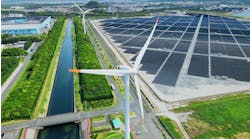The number of net-zero energy buildings worldwide is forecasted to experience significant expansion in the coming years, according to a new report from global technology intelligence firm ABI Research. Driven by climate imperatives, policy support, and maturing technologies, the market is forecasted to grow at a 29% Compound Annual Growth Rate (CAGR) through 2027.
“With buildings accounting for over one-third of global energy consumption, the real estate sector is under mounting pressure to embrace net-zero,” said Dominique Bonte, vice president of end markets at ABI Research. “Governments, corporations, and society at large recognize the pivotal role buildings play in reducing emissions and energy use.”
Despite currently representing just 0.023% of global buildings, the net-zero segment is gaining strong momentum. The report projects over 5,500 commercial and residential net-zero buildings globally by 2027, up from 1,200 in 2022. While still a niche, this growth signals the accelerating transition toward high-performance real estate.
Progress enabled by technology
The evolution is enabled by progress across renewable energy, efficiency software, and sustainable materials. Solar photovoltaics, geothermal heating, and battery storage make onsite zero-carbon energy generation achievable. Digital twin systems and building management software from companies such as Siemens, Schneider Electric, and Univers optimize performance. Carbon-storing materials and circular construction techniques reduce lifecycle impacts.
Regions leading the net-zero building charge include North America, Western Europe, and progressive urban centers in Asia Pacific. Supportive policies, technology leadership, and climate awareness drive these markets.
Upfront, net-zero buildings carry a 5-19% premium for commercial and 5-15% for residential. However, the investment pays back over decades of operations through dramatically lowered utility and maintenance costs. Demonstrating positive value impacts for owners and occupants remains a priority.
“Technologies now exist to make net-zero energy feasible at scale,” Bonte added. “But the real estate ecosystem must continue collaborating across construction, policy, finance, and technology to make it accessible and attractive for owners globally.”
These findings are from ABI Research’s From Energy-Efficient to Net-Zero Buildings application analysis report. The report is part of the company’s Smart Buildings research service, which includes research, data, and ABI Insights. Based on extensive primary interviews, Application Analysis reports present an in-depth analysis of key market trends and factors for a specific technology.


